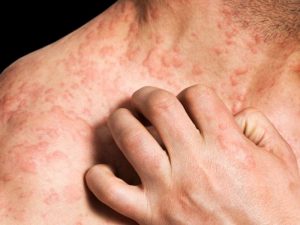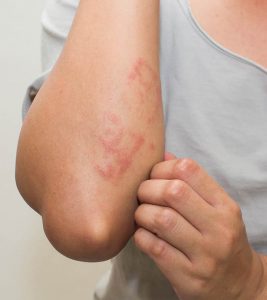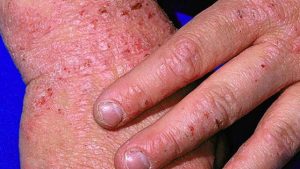What’s to know about eczema?
Different stages and types of eczema affect 31.6 percent of people in the United States.
The word “eczema” is also used specifically to talk about atopic dermatitis, the most common type of eczema.
“Atopic” refers to a collection of diseases involving the immune system, including atopic dermatitis, asthma, and hay fever. Dermatitis is an inflammation of the skin.
Some people outgrow the condition, while others will continue to have it throughout adulthood.
This MNT Knowledge Center article will explain what eczema is and discuss the symptoms, causes, treatments, and types.

Fast facts on eczemaHere are some key points about eczema. More detail and supporting information is in the main article.
- Certain foods can trigger symptoms, such as nuts and dairy.
- Symptoms vary according to the age of the person with eczema, but they often include scaly, itchy patches of skin.
- Eczema can also be triggered by environmental factors like smoke and pollen. However, eczema is not a curable condition.
- Treatment focuses on healing damaged skin and alleviating symptoms. There is not yet a full cure for eczema, but symptoms can be managed.
- Eczema is not a contagious condition.
Symptoms

The symptoms of atopic dermatitis can vary, depending on the age of the person with the condition.
Atopic dermatitis commonly occurs in infants, with dry and scaly patches appearing on the skin. These patches are often intensely itchy.
Most people develop atopic dermatitis before the age of 5 years. Half of those who develop the condition in childhood continue to have symptoms as an adult.
However, these symptoms are often different to those experienced by children.
People with the condition will often experience periods of time where their symptoms flare up or worsen, followed by periods of time where their symptoms will improve or clear up.
Symptoms in infants under 2 years old
- Rashes commonly appear on the scalp and cheeks.
- Rashes usually bubble up before leaking fluid.
- Rashes can cause extreme itchiness. This may interfere with sleeping. Continuous rubbing and scratching can lead to skin infections.
Symptoms in children aged 2 years until puberty
- Rashes commonly appear behind the creases of elbows or knees.
- They are also common on the neck, wrists, ankles, and the crease between buttock and legs.
Over time, the following symptoms can occur:
- Rashes can become bumpy.
- Rashes can lighten or darken in color.
- Rashes can thicken in a process known as lichenification. The rashes can then develop knots and a permanent itch.
Symptoms in adults
- Rashes commonly appear increases of the elbows or knees or the nape of the neck.
- Rashes cover much of the body.
- Rashes can be especially prominent on the neck, face, and around the eyes.
- Rashes can cause very dry skin.
- Rashes can be permanently itchy.
- Rashes in adults can be more scaly than those occurring in children.
- Rashes can lead to skin infections.
Adults who developed atopic dermatitis as a child but no longer experience the condition may still have dry or easily-irritated skin, hand eczema, and eye problems.
The appearance of skin affected by atopic dermatitis will depend on how much a person scratches and whether the skin is infected. Scratching and rubbing further irritate the skin, increase inflammation, and make itchiness worse.

Treatment
There is no cure for eczema. Treatment for the condition aims to heal the affected skin and prevent flare-ups of symptoms. Doctors will suggest a plan of treatment based on an individual’s age, symptoms, and current state of health.
For some people, eczema goes away over time. For others, it remains a lifelong condition.
Home care
There are numerous things that people with eczema can do to support skin health and alleviate symptoms, such as:
- taking lukewarm baths
- applying moisturizer within 3 minutes of bathing to “lock in” moisture
- moisturizing every day
- wearing cotton and soft fabrics, and avoiding rough, scratchy fibers and tight-fitting clothing
- using a mild soap or a non-soap cleanser when washing
- air drying or gently patting skin dry with a towel, rather than rubbing the skin dry after bathing
- where possible, avoiding rapid changes of temperature and activities that make you sweat
- learning and avoiding individual eczema triggers
- using a humidifier in dry or cold weather
- keeping fingernails short to prevent scratching from breaking the skin
Medications
There are several medications that doctors can prescribe to treat the symptoms of eczema, including:
- Topical corticosteroid creams and ointments: These are a type of anti-inflammatory medication and should relieve the main symptoms of eczema, such as skin inflammation and itchiness. They are applied directly to the skin. If you want to buy topical corticosteroid creams and ointments, then there is an excellent selection online with thousands of customer reviews.
- Systemic corticosteroids: If topical treatments are not effective, systemic corticosteroids can be prescribed. These are either injected or taken by mouth, and they are only used for short periods of time.
- Antibiotics: These are prescribed if eczema occurs alongside a bacterial skin infection.
- Antiviral and antifungal medications: These can treat fungal and viral infections that occur.
- Antihistamines: These reduce the risk of nighttime scratching as they can cause drowsiness.
- Topical calcineurin inhibitors: This is a type of drug that suppresses the activities of the immune system. It decreases inflammation and helps prevent flare-ups.
- Barrier repair moisturizers: These reduce water loss and work to repair the skin.
- Phototherapy: This involves exposure to ultraviolet A or B waves, alone or combined. The skin will be monitored carefully. This method is normally used to treat moderate dermatitis.
Even though the condition itself is not yet curable, there should be a particular treatment plan to suit each person with different symptoms. Even after an area of skin has healed, it is important to keep looking after it, as it may easily become irritated again.
Causes

Pollen is one of the many potential triggers of eczema.
The specific cause of eczema remains unknown, but it is believed to develop due to a combination of genetic and environmental factors.
Eczema is not contagious.
Children are more likely to develop eczema if a parent has had the condition or another atopic disease.
If both parents have an atopic disease, the risk is even greater.
Environmental factors are also known to bring out the symptoms of eczema, such as:
- Irritants: These include soaps, detergents, shampoos, disinfectants, juices from fresh fruits, meats, or vegetables.
- Allergens: Dust mites, pets, pollens, mold, and dandruff can lead to eczema.
- Microbes: These include bacteria such as Staphylococcus aureus, viruses, and certain fungi.
- Hot and cold temperatures: Very hot or cold weather, high and low humidity, and perspiration from exercise can bring out eczema.
- Foods: Dairy products, eggs, nuts and seeds, soy products, and wheat can cause eczema flare-ups.
- Stress: This is not a direct cause of eczema but can make symptoms worse.
- Hormones: Women can experience increased eczema symptoms at times when their hormone levels are changing, for example during pregnancy and at certain points in the menstrual cycle.
Types
There are many different types of eczema. While this article has focused mainly on atopic dermatitis, other types include:
- Allergic contact dermatitis: This is a skin reaction following contact with a substance or allergen that the immune system recognizes as foreign.
- Dyshidrotic eczema: This is an irritation of the skin on the palms of the hands and the soles of the feet. It is characterized by blisters.
- Neurodermatitis: This forms scaly patches of skin on the head, forearms, wrists, and lower legs. It is caused by a localized itch, such as an insect bite.
- Nummular eczema: These show as circular patches of irritated skin that can be crusted, scaly, and itchy.
- Seborrheic eczema: This forms oily, scaly, yellowish patches of skin, usually on the scalp and face.
- Stasis dermatitis: This is a skin irritation of the lower leg usually related to circulatory problems.

For more information Visit Our Clinic Now
We prove full treatment of a patient suffering from all Skin Related Problems.
Visit Our Website Today:-www.drgyanhomoeo.com
Book Your Appoint Now:-https://www.drgyanhomoeo.com/book-an-appointment/





